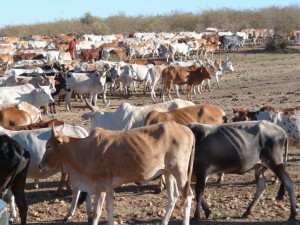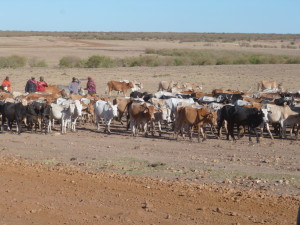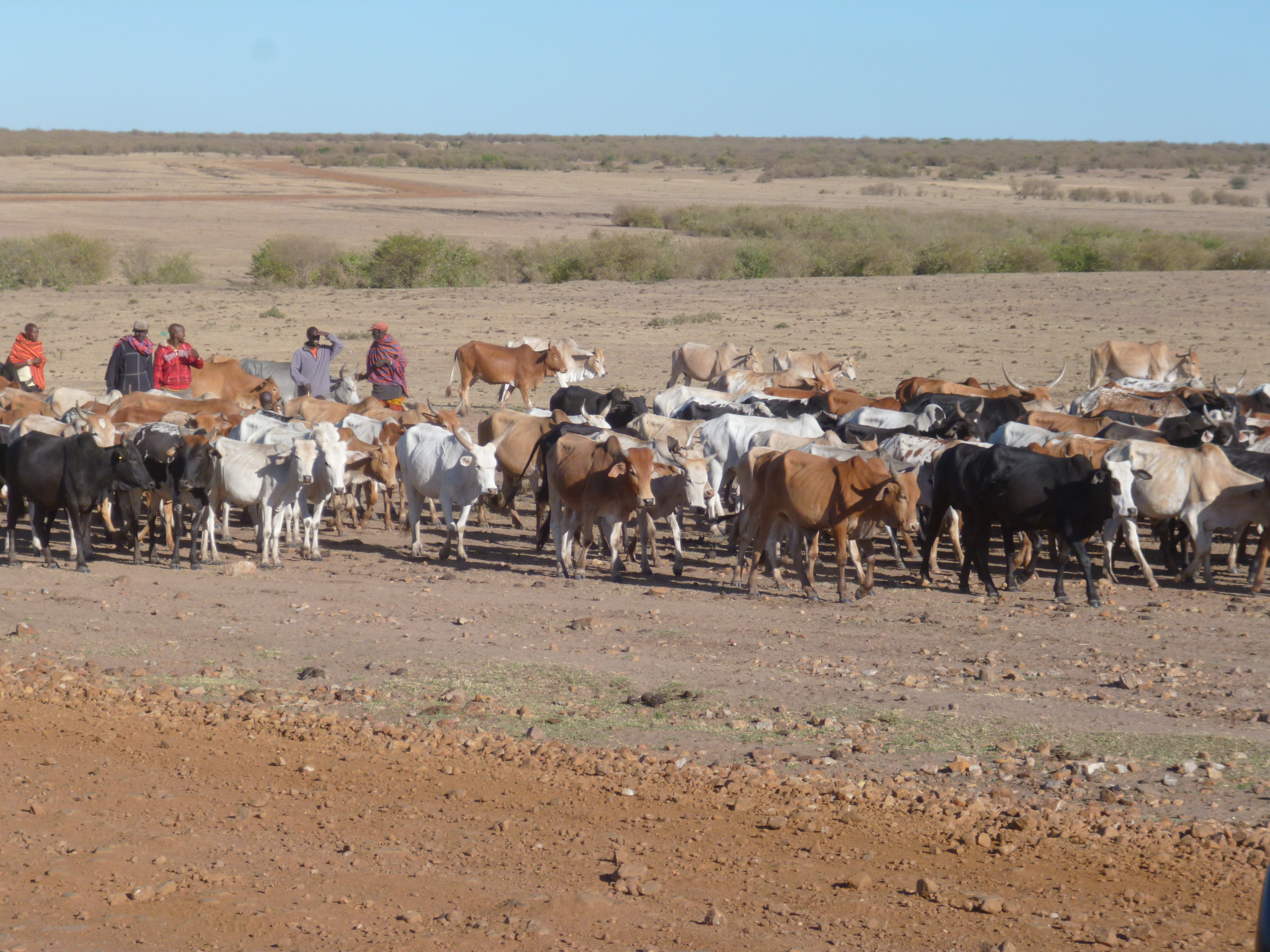Source : DLCI Journal 5
By Abdikarim Daud and Peter Mbiyu, Kenya Markets Trust
Building a thriving market-based livestock insurance sub-sector in Kenya is not a straighƞ orward endeavour. An article in REGLAP Journal 4, which detailed the progress being made in northern Kenya with Index Based Livestock Insurance, concluded that IBLI will not be entirely commercially viable without subsidy support for product development, knowledge transfer and even product premiums. The need for government involvement is explored further in this article.
Moving from relief towards resilience Private insurance taken out by pastoralists to help them rebuild their herds in the event of livestock mortality through drought is a relatively new undertaking in northern Kenya, and has had little government involvement to date. Governments have tended to alleviate the eff ects of drought by providing post-disaster relief. This sort of aid can discourage alternati ve disaster mitigate on programmes, such as insurance, which can provide more effi cient fi nancial solutions and can reduce the magnitude of losses from future events: recipients become dependent on relief measures rather than taking preventive steps themselves—‘the Samaritan’s dilemma’.36 Although social safety net programmes serve as important support mechanisms to the most vulnerable and poor in the population, it is also important to avoid dependency where there are opportunites available that can help people develop resilience. Index Based Livestock insurance (IBLI) is an innovative approach that is aimed at cushioning livestock owners from risks such as drought. Although not appropriate for all livestock owners (there are a considerable number of people who own too few livestock units to make extensive livestock production viable), there are many livestock owners in Northern Kenya that own viable herds, who would be able to pay the insurance premiums, and for whom the product could be a viable risk management mechanism.
The pilot stage of IBLI has shown considerable potentetial, but there is now a need for government involvement to make it possible for more people, with capacity, to buy livestock insurance. Addressing systemic risk through a risk-sharing framework One central argument for government intervention in the provision, administration, and oversight of livestock insurance programmes involves the presence of systemic risk in the sector (that is, risk that aff ects a large number of herders simultaneously). The systemic component of livestock risks can generate major losses in the porƞ olio of insurers, making it impossible for a single or pool of reinsurers, to cover such a large liability, thereby constraining the growth and sustainability of the sector. The argument follows that, because private reinsurance markets may not be able to absorb the catastrophic risks associated with livestock, the government should assume the role of a reinsurer of last resort. The government is assumed to have “deeper pockets” than private reinsurers and thus be bearable to provide the capital necessary to fi nance such systemic risks. The systemic risk argument for government support is persuasive, but for reinsurers that have an international portfolio, risks can be spread and diversifi ed across diff erent sectors. National government involvement could be bear targeted at establishing a risk-sharing framework for the industry—a framework that would help spread the risks across all the players. Such a framework would include multiple layers of risk absorption: a. Self-insurance: a certain minimum percentage of the losses to be retained by the owners of livestock. b. Underwriter insurance: from the minimum per cent of self-insured loss up to a certain limit of the losses suff ered by the owner of livestock, the insurance companies to take over. c. Catastrophic insurance by the Government (National/ County).

The Government intervenes beyond certain limits of the losses (catastrophic levels) to further cushion the underwriters. This should not be considered through a safety net programme, but rather through risk sharing method with the insurance companies.
Providing information support for livestock insurance In developing countries a further impediment to the provision of livestock insurance is the lack of information support. Data is required for all aspects of the insurance product: product design, marketing, and for determination of payments. It is too costly for individual insurance companies to be able to collect and analyse the required data at a signifi cant scale. The Government needs to create public goods, such as agricultural and weather databases and livestock risk models, providing domestic insurers with reliable data and quantitative tools to bear assess their catastrophe risk exposure and thus design sound insurance products. This is an important opportunity for government participatory on in making data available to underwriters at an aff ordable cost. Any data collectin on process needs to be transparent, subject to strict protocols, and handled by an impartial third party. Unfortunately, in Kenya this is not usually the case. Rainfall data has been collected for decades using manual rainfall gauges, which expose the data to erroneous reporting; and the collection of livestock census and ownership data is also not always conducted as it should be, usually because of lack of fi nancial and human capacity in stastical departments. Lack of historical data can prevent the proper modelling of the underlying risk, leading to the incorrect pricing of livestock insurance products. Within IBLI specifi cally, index data on forage availability collected by satellite is one way of getƫing information for cross checking livestock mortality information.

“The systemic risk for insurers within the livestock sector in the ASALs is due to the huge climatic risks. To promote entry of more insurers the government could consider sharing the risk with the insurers in the early stages of growth, before a criƟ cal mass has subscribed and therefore the spread of the risk is greater.”
Sometimes it is necessary to pull together other sources of information and data to give more strength to the satellite images. The state National Drought Management Authority collects regular data on forage availability, the patterns of rain and the body sizes of livestock, whilst the Kenya Meteorological Service provides information on the weather and climate. The pulling together of these critical sets of information can help in making important scientific decisions on the levels of drought, and hence is a key pillar to index based livestock insurance. Overcoming the lack of an insurance culture A commonly cited reason for the low demand for agricultural insurance in developing countries is the limited understanding of its benefi ts. Insurance is often viewed as a non-viable investment because premiums are collected every year but indemnifies are paid much less frequently. The general population perceives insurance—particularly agricultural insurance, which, by definatio on, pays only when infrequent events occur—as the privilege of the rich. A unique additional challenge also exists in Northern Kenya where a majority of the population are Islamic, and insurance products need to be Sharia compliant. Market actors with compliant products are already in the market, but are limited, leading to lack of competition.
The Government, in collaboration with other technical institutions, could provide technical support in outreach and design of specifi c insurance products by establishing collaborative research initiatives. be very aware of their production risks, they often underestimate the likelihood or severity of catastrophic events. Government and development partners can play an important role in providing awareness and education programmes, and in supporting the marketing and promotional programmes of the private commercial insurance sector. Public education to increase the level of awareness about insurance in the target areas requires signifi cant resources to help increase uptake. Government can play a signifi cant role in this area together with the Insurance Regulatory Authority (IRA), Association of Kenya Insurers (AKI) and insurance companies, through marketing and training. The government could also use its extension system to facilitate outreach and education to enhance the insurance culture. This will lower the transaction costs for the underwriters and promote growth of the sector. Insurance is not an easy product to sell even in relatively mature markets; it requires a good network of sales agents who can explain the product to the customer, do the documentation and fi le the claims when the incidents occur. Such a network of agents does not exist in Northern Kenya at the moment. Additional incentives may be required from government, such as promoting communication infrastructure e.g. mobile telephone networks and roads.
Developing a regulatory framework The regulatory frameworks governing insurance markets in Kenya are currently underdeveloped, with no specifi c regulations and guidelines on micro-insurance and IBLI. As a result, regulatory overlay may inhibit increased penetration of insurance, including livestock insurance. Innovative insurance products, such as index-based livestock insurance or parametric (weather-based) insurance, require an eff ective, enabling, regulatory framework. Government must also carefully analyse the fi scal implications of any government sponsored insurance programmes, whose costs may not be sustainable in the long term. Subsidies on livestock insurance premiums should be carefully considered because they can distort price signals and provide inappropriate incentives to livestock herders to take beyond reasonable risk.
A survey by the World Bank concludes that premium subsidies are not a prerequisite if livestock herders are to purchase voluntary livestock insurance.37 Where subsidies are off ered, planners should carefully identify which benefi ciaries, livestock sectors, and regions to target; and whether the subsidies will be provided for a limited period or phased out over time once insurance takes off and achieves a critical presence in the market. Government support is now crucial to further stimulate the growth of the emerging market-based livestock insurance sector in Kenya. Support is needed to help ease the barriers to entry (particularly on the information requirements), and to stimulate the involvement of more insurers by helping to spread the risks and establish a regulatory framework. Government supported public awareness campaigns can target livestock owners, address misunderstandings about insurance, and help those with viable herds to see insurance as an alternative resilience building strategy in the drylands.
For further information please contact: Abdikarim Daud at: adaud@kenyamarkets.org or Peter Mbiyu at: pmbiyu@kenyamarkets.org www.kenyamarkets.org














